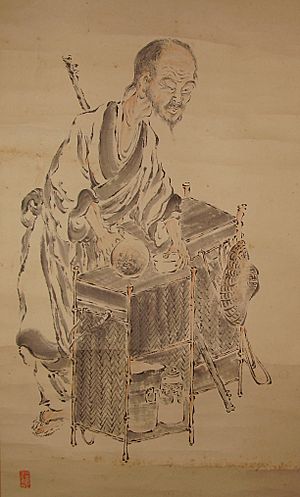Baisao facts for kids
Baisao (Japanese: 売茶翁, Hepburn: baisaō) (1675–1763) was a famous Japanese Buddhist monk. He belonged to the Ōbaku school of Zen Buddhism. Baisao became well-known for traveling around Kyoto and selling tea. People admired Baisao during his life and after he died. This helped make `sencha` tea popular. It also led to the creation of the `sencha` tea ceremony.
Contents
Who Was Baisao?
Baisao had many names during his life. This was common back then. As a child, he was called Shibayama Kikusen. When he became a monk, his Zen name was Gekkai Gensho.
The name Baisao is a nickname. It means "old tea seller." He got this name because he sold tea in the Kyoto area. Later in life, he stopped being a priest. He then used the name Ko Yugai.
Baisao's Early Life
Baisao was born in a town called Hasuike. This was in what was then Hizen Province. His father died when Baisao was nine years old.
Baisao became a Zen Buddhist monk at Ryushinji temple. This was an Ōbaku temple. His teacher, Kerin Doryo, learned directly from Ingen. Ingen was the founder of the Ōbaku school.
Starting in 1696, Baisao traveled for several years. He studied at different temples in Japan. Then, Baisao returned to his temple. He worked there until 1723. His mother also died that year. In 1724, Baisao was 49 years old. He left the monastery and moved to Kyoto. He lived there for the rest of his life. In Kyoto, Baisao quickly made friends. Many leading artists, monks, and writers became his friends.
Baisao and Tea
Around 1735, Baisao started selling tea. He sold it in beautiful spots around Kyoto. At this time, he was still a priest. Baisao never sold his tea for a set price. Instead, he carried a bamboo tube. People put donations into it.
He lived a simple life. He used the small donations from his tea selling to buy food. He carried all his tea tools in a woven bamboo basket. He called it Senka, which means "den of the sages." He carried it on a stick over his shoulder.
What is Sencha Tea?
Baisao's way of making tea was called `sencha`. This means "simmered tea." For this, whole tea leaves were put into boiling water. They simmered for a short time.
This `sencha` style was different from `matcha`. `Matcha` was the most common tea in Japan then. `Matcha` is made from tea leaves ground into a fine powder. This powdered tea was popular in China during the Song Dynasty. Zen Buddhist monks first brought `matcha` to Japan.
The Ōbaku Zen school focused on brewing loose leaf green tea. This style became popular in China during the Ming dynasty. People who liked `sencha` did not like the strict rules of the traditional `chanoyu` tea ceremony. `Chanoyu` uses `matcha`.
Many Japanese monks and thinkers liked the simplicity of adding tea leaves to water. They admired the free spirit of ancient Chinese wise people. Baisao believed tea could lead to spiritual understanding. He wrote about this often in his poems.
How Sencha Tea Leaves Were Made
We don't know where Baisao first got his tea leaves. But by 1738, `sencha` brewing became popular. One of Baisao's friends was a tea grower in Uji. He created new ways to make tea leaves. This new tea was named after the brewing method.
This `sencha` tea was made from whole, young leaves. They were steamed and then dried. This is different from the usual Chinese way of making loose leaf tea. The Chinese method does not involve steaming. Baisao praised this new tea highly. Today, `sencha` mostly refers to the tea leaves made this way. It does not refer to the brewing method itself.
Baisao's Later Life
In 1745, Baisao was seventy years old. He stopped being a monk. He changed his name to Ko Yugai. He stopped selling tea in 1755.
Baisao was famous. He wanted to prevent a new `sencha` tradition from becoming too strict. He did not want it to be like the formal `chanoyu` ceremony he disliked. So, Baisao burned many of his own tea tools. He did this just before he died. This was a clear act against the `chanoyu` tradition. That tradition honored the tools used by famous tea masters.
Baisao's Writings
Baisao's poetry and beautiful writing (calligraphy) are important in Japan's Zen history. This is especially true in Kyoto, where Baisao was well known. Artists in 18th-century Kyoto admired his poetry. Kyoto was more "liberal" than the capital city of Edo (modern Tokyo). More than 100 of his poems still exist today.
Some of Baisao's writings were published in 1748. The book was called A Collection of Tea Documents from the Plum Mountain. In this book, Baisao argued that `sencha` was better than `chanoyu`. He wrote that priests who performed the `chanoyu` tea ceremony were very far from the example of the ancient wise people.
Baisao's Lasting Influence
After Baisao died, a `sencha` tea ceremony soon appeared. This happened even though he destroyed his tea tools. His friend Kimura Kenkadō published detailed descriptions and pictures of Baisao's tea tools. Kimura also had craftsmen make copies of some of the burned tools.
Kimura and others helped people admire Baisao. They wrote detailed guides for brewing loose leaf tea. The priest Daiten Kenjo wrote about two ways to brew loose leaf tea. One was called `sencha`, which Baisao used. The other was called `hocha`. This is the method generally used today. Hot water is poured over tea leaves in a cup. Daiten also suggested using tea tools similar to Baisao's.
Today, Baisao is seen as one of the first `sencha` masters. After his death, `sencha` continued to grow in popularity. It slowly replaced `matcha` as the most popular tea in Japan.
Images for kids



